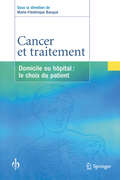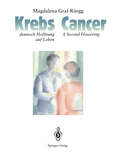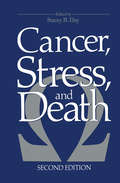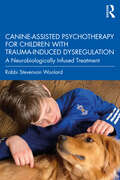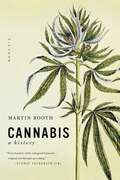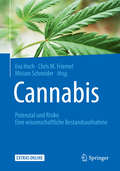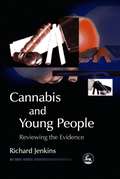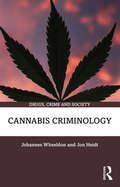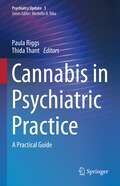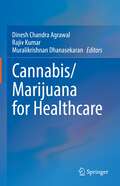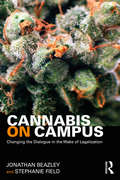- Table View
- List View
Cancer, Culture and Communication
by Rhonda J. MooreThis volume creates a multi-disciplinary dialogue about clinician-patient communication. It offers a description of the relevance of culture as a contextual effect that impacts the clinician-patient relationship. Some topics addressed include: oncology care, quality of life issues, supportive survivorship, etc. It is for physicians, nurses, hospice and palliative care professionals and public health professionals.
Cancer et traitement: Domicile ou hôpital: le choix du patient (Psycho-Oncologie)
by Marie-Édérique BacquéCet ouvrage fait le point sur les besoins, les attentes et les difficultés de la prise en charge d’un patient atteint de cancer à domicile ou à l’hôpital. En effet, si le nombre de cas de cancers augmente dans les pays occidentaux, leur prise en charge est en pleine évolution. L’accent est aujourd’hui mis sur une annonce plus humaine de la maladie, des traitements moins agressifs et une plus grande qualité de vie. Les patients, mieux informés souhaitent souvent être traités à la maison. La durée de la survie s’allongeant, les séjours hospitaliers sont réduits et choisis. Les équipes de soins à domicile relaieront prochainement plus facilement l’hôpital, grâce à des méthodes spécifiques de communication et aux réseaux de soins. Ici, tous les intervenants impliqués dans l’approche psycho-oncologique du patient abordent le choix du lieu et des moyens de traitements des patients : du médecin généraliste au psychologue, du cancérologue à l’unité de soins palliatifs mobile.
Cancer-gate: How to Win the Losing Cancer War (Policy, Politics, Health and Medicine Series)
by Samuel S. EpsteinAward-winning author, Samuel S. Epstein, M.D., whose 1978 book ""The Politics of Cancer"" shook the political establishment by showing how the federal government had been corrupted by industrial polluters, has written a book that is sure to be of equal consequence. ""Cancer-Gate: How to Win the Losing Cancer War"" is a groundbreaking new book. It warns that, contrary to three decades of promises, we are losing the winnable war against cancer, and that the hand-in-glove generals of the federal National Cancer Institute (NCI) and the private ""nonprofit"" American Cancer Society (ACS) have betrayed us.These institutions, Epstein alleges, have spent tens of billions of taxpayer and charity dollars primarily targeting silver-bullet cures, strategies that have largely failed, while virtually ignoring strategies for preventing cancer in the first place. As a result, cancer rates have escalated to epidemic proportions, now striking nearly one in every two men, and more than one in every three women. This translates into approximately 50 percent more cancer in men, and 20 percent more cancer in women over the course of just one generation.
Cancer-gate: How to Win the Losing Cancer War (Policy, Politics, Health and Medicine Series)
by Samuel S. EpsteinAward-winning author, Samuel S. Epstein, M.D., whose 1978 book ""The Politics of Cancer"" shook the political establishment by showing how the federal government had been corrupted by industrial polluters, has written a book that is sure to be of equal consequence. ""Cancer-Gate: How to Win the Losing Cancer War"" is a groundbreaking new book. It warns that, contrary to three decades of promises, we are losing the winnable war against cancer, and that the hand-in-glove generals of the federal National Cancer Institute (NCI) and the private ""nonprofit"" American Cancer Society (ACS) have betrayed us.These institutions, Epstein alleges, have spent tens of billions of taxpayer and charity dollars primarily targeting silver-bullet cures, strategies that have largely failed, while virtually ignoring strategies for preventing cancer in the first place. As a result, cancer rates have escalated to epidemic proportions, now striking nearly one in every two men, and more than one in every three women. This translates into approximately 50 percent more cancer in men, and 20 percent more cancer in women over the course of just one generation.
Cancer Genetics and Psychotherapy
by Parvin MehdipourThe aim of this book is to provide the readers with the most comprehensive and latest accounts of research and development in this field by emphasizing on the manner of relation between doctors and cancer patients in direction of improving the patients’ style of life. This book, partly, will deal with psychotherapy by considering cancer patients, benefits, hazards and also social impacts including life style. The social supports as the key and influential paradigms will be challenged as a comparative insight by considering the global unity in order to provide a reasonable model to improve the interaction between cancer and psychological nest. In this book, the real stories of cancer patient will be also provided. The initial insight of sections includes: 1) Brief classifications and key points of clinical and histopatological aspects of each organ. 2) Brief view of genetic alterations in each organ. 3) Therapeutic aspects. 4) Brief classifications and key points of Psychology in cancer. 5) The interactions of clinical aspects with psychological field.
Cancer, Nutrition, and Eating Behavior: A Biobehavioral Perspective (Psychology Revivals)
by Thomas G. BurishThe majority of cancer-related deaths are associated with nutritional problems. The major role that nutrition and diet play in the development and course of cancer had only been recently appreciated, and relatively little had been written on the topic in general. A critical component of nutrition and diet is eating behavior. Originally published in 1985, the purpose of this book was to meet the needs of both the clinician and the researcher by bringing together data and theory about nutrition and cancer from several disciplines, as considered from a biobehavioral perspective. The first chapter of the book provides an overview of the purposes and organization of the volume. The rest is divided into 3 parts. Part 1 focuses on basic research concerned with the nature and development of taste aversions and taste preferences in human and animals. Part 2 applies the basic processes reviews in the first part to the cancer area, focusing on eating and nutritional problems related to both tumor development and to learned processes that develop as a result of being exposed to radiotherapy and chemotherapy treatments. Part 3 focuses on identifying and evaluating intervention strategies for improving the nutritional status of people with cancer or at high risk for developing cancer.
Cancer, Nutrition, and Eating Behavior: A Biobehavioral Perspective (Psychology Revivals)
by Thomas G. Burish Sandra M. Levy Beth E. MeyerowitzThe majority of cancer-related deaths are associated with nutritional problems. The major role that nutrition and diet play in the development and course of cancer had only been recently appreciated, and relatively little had been written on the topic in general. A critical component of nutrition and diet is eating behavior. Originally published in 1985, the purpose of this book was to meet the needs of both the clinician and the researcher by bringing together data and theory about nutrition and cancer from several disciplines, as considered from a biobehavioral perspective. The first chapter of the book provides an overview of the purposes and organization of the volume. The rest is divided into 3 parts. Part 1 focuses on basic research concerned with the nature and development of taste aversions and taste preferences in human and animals. Part 2 applies the basic processes reviews in the first part to the cancer area, focusing on eating and nutritional problems related to both tumor development and to learned processes that develop as a result of being exposed to radiotherapy and chemotherapy treatments. Part 3 focuses on identifying and evaluating intervention strategies for improving the nutritional status of people with cancer or at high risk for developing cancer.
Cancer, Stress, and Death
by Stacey B. DayThis book has been well received in many places and in many countries. It was awarded a ranking in the top ten publications on behavioral medicine in the year that it first appeared. When, in 1977, we began to fit the components of Cancer, Stress, and Death together, the established medical view was that each subject repre sented a different discipline, and that to integrate fields so diverse in information content was to seek to achieve a synthesis beyond reasonable limits. Had we been required to concern ourselves with the knowledge of each component in its entirety, this might have been so, but our concern, of course, was to integrate only those items of knowledge in any one field that could bear upon the field of interest of another. Moreover, we were concerned that physi cians and scientists take account of the inner forces that shape motivation and individual behavior, as well as the cultural identity of individuals, and we hoped that the biopsychosocial way in which we believed would gain ground and win support. Now, with need for a second edition, one can hardly conceive of not bringing together diverse contributions in one volume. Such syntheses as we have made clearly confirm that one can arrive at several levels of understanding of human situations through wise integration of biological paradigms within various social, cultural, and psychological parameters-which essentially is a simple way of defining the biopsychosocial way.
Canine-Assisted Interventions: A Comprehensive Guide to Credentialing Therapy Dog Teams
by John-Tyler Binfet Elizabeth Kjellstrand HartwigCovering principles of therapy dog team training, assessment, skills, and ongoing monitoring, Canine-Assisted Interventions provides guidance on the most evidence-based methods for therapy dog team welfare, training, and assessment. The authors offer a linear approach to understanding all aspects of the screening, assessment, and selection of dog-handler teams by exploring the journey of dog therapy teams from assessment of canines and handlers to the importance of ongoing monitoring, recredentialing, and retirement. In addition to reviewing key findings within the field of human-animal interactions, each chapter emphasizes skills on both the human and dog ends of the leash and makes recommendations for research-informed best practices. To support readers, the book culminates with checklists and training resources to serve as a quick reference for readers. This book will be of great interest for practitioners, in-service professionals, and researchers in the fields of canine-assisted interventions and counseling.
Canine-Assisted Interventions: A Comprehensive Guide to Credentialing Therapy Dog Teams
by John-Tyler Binfet Elizabeth Kjellstrand HartwigCovering principles of therapy dog team training, assessment, skills, and ongoing monitoring, Canine-Assisted Interventions provides guidance on the most evidence-based methods for therapy dog team welfare, training, and assessment. The authors offer a linear approach to understanding all aspects of the screening, assessment, and selection of dog-handler teams by exploring the journey of dog therapy teams from assessment of canines and handlers to the importance of ongoing monitoring, recredentialing, and retirement. In addition to reviewing key findings within the field of human-animal interactions, each chapter emphasizes skills on both the human and dog ends of the leash and makes recommendations for research-informed best practices. To support readers, the book culminates with checklists and training resources to serve as a quick reference for readers. This book will be of great interest for practitioners, in-service professionals, and researchers in the fields of canine-assisted interventions and counseling.
Canine-Assisted Psychotherapy for Children with Trauma-Induced Dysregulation: A Neurobiologically Infused Treatment
by Robbi Stevenson WoolardThis book provides mental health researchers and clinicians with valuable insight into the pathway that leads from developmental trauma to dysregulation and psychopathology. Incorporating science that explains the impact of early trauma, this book details the theory, mechanisms, and applications of neurobiologically informed canine-assisted psychotherapy, using illuminating case studies that demonstrate the efficacy of the author’s model.
Canine-Assisted Psychotherapy for Children with Trauma-Induced Dysregulation: A Neurobiologically Infused Treatment
by Robbi Stevenson WoolardThis book provides mental health researchers and clinicians with valuable insight into the pathway that leads from developmental trauma to dysregulation and psychopathology. Incorporating science that explains the impact of early trauma, this book details the theory, mechanisms, and applications of neurobiologically informed canine-assisted psychotherapy, using illuminating case studies that demonstrate the efficacy of the author’s model.
Canine Cognition and the Human Bond (Nebraska Symposium on Motivation #69)
by Jeffrey R. StevensDogs are a valued part of millions of households worldwide. They also serve many functions in human societies from herding livestock to detecting drugs, explosives, or illegal wildlife to providing physical assistance or emotional support to those in need. Yet, in terms of behavior and cognition, dogs have only become a serious subject of scientific study in the last 20 years. Similarly, we have recently witnessed a sharp increase in studies of canine-human interaction, exploring the motivational, emotional, cognitive, physiological, and neural mechanisms of dogs on human psychology and well-being. This book is a collection of chapters stemming from the Nebraska Symposium on Motivation, which focused on Canine Cognition and the Human Bond. The primary goal of this symposium was to bring together researchers from psychology, biology, neuroscience, and anthropology to delve deeper into the canine-human bond. These chapters describe the current state of knowledge from international experts in the fields of canine cognition and canine-human interaction. Bridging these two areas can help us better understand the canine-human bond, potentially improving the lives of both dogs and people.
Cannabinoids and the Brain
by Attila KöfalviEndocannabinoids have tremendous therapeutic potential. This book introduces readers to our current understanding of the neurobiology of endocannabinoids and related systems, detailing their pathophysiological role and therapeutic potential. Authors, experienced clinical investigators, present and analyze results of recent clinical trials as well as the development of new therapeutic strategies and medicines.
Cannabinoids as Therapeutics (Milestones in Drug Therapy)
by Raphael MechoulamOnly a few years ago the endocannabinoid system was unknown. Today we are aware that endocannabinoids are involved in many of the functions of the mammalian body - in neuroprotection, appetite and suckling, pain, reproduction, anxiety, memory, bone formation etc. This volume presents an up-to-date picture of some of the major fields of endocannabinoid research. It summarizes the actions of the endocannabinoids on various physiological systems and opens new therapeutic windows to a large number of diseases.The first chapter, on the use of Cannabis in India, can be viewed as an expression of thanks to the herbal practitioners, who for centuries passed on the medical traditions associated with the drug. The chapter on chemistry is a short summary of active plant, synthetic and endogenous cannabinoids being investigated today, many of which are mentioned later in the book. Cannabidiol is an unusual cannabinoid - it does not bind to the known receptors and yet exerts a variety of effects. Hence a chapter is devoted to it. Further chapters deal with the endocannabinoid system and the endocannabinoids in a variety of conditions and physiological systems. The concluding chapter describes the research done on Sativex®, a standardized plant extract, shortly to be introduced in Canada as a drug for multiple sclerosis.The intended audience is drug researchers (medicinal chemists, pharmacologists, clinicians), neuroscientists, physiologists, and clinicians interested in the effect of the endocannabinoid system in various physiological systems.
Cannabis: A History (PDF)
by Martin BoothTo some it's the classic gateway drug, to others it is a harmless way to relax, or provide relief from pain. Some fear it is dangerous and addictive, while others feel it should be decriminalized. Whatever the viewpoint, cannabis incites debate at every level, and the effect it has on every corner of the globe is undeniable. In this comprehensive study, Martin Booth crafts a tale of medical advance and religious enlightenment; of political subterfuge and law enforcement; of cunning smugglers, street pushers, gang warfare, writers, artists, and musicians. And above all, Booth chronicles the fascinating process through which cannabis became outlawed throughout the Western world, and the effect such legislation has had on the global economy.
Cannabis: Eine wissenschaftliche Bestandsaufnahme
by Eva Hoch Chris Maria Friemel Miriam SchneiderDieses Buch fasst den aktuellen Forschungsstand zum Thema Cannabis zusammen. Hierfür wurden alle bedeutsamen, in den letzten 10 Jahren in deutscher und englischer Sprache publizierten Forschungsarbeiten systematisch recherchiert und ausgewertet. Dargestellt werden: - psychische, organische und soziale Risiken des Konsums pflanzlicher und synthetischer Cannabisprodukte zu Rauschzwecken, - Wirksamkeit, Verträglichkeit und Sicherheit von Cannabisarznei bei organischen und psychischen Erkrankungen, - Motive und Erwartungen eines nichtärztlich verordneten Gebrauchs von Cannabis im Sinne einer Selbstmedikation. Die Expertise liefert einen umfassenden Überblick über die aktuelle Literatur. Sie bewertet das therapeutische Potenzial und die Risiken von Cannabis entsprechend internationaler methodischer Vorgaben der evidenzbasierten Medizin. Die Expertise dient somit als solides Nachschlagewerk. Ihr Auftraggeber war das Bundesministerium für Gesundheit.
Cannabis and Young People: Reviewing the Evidence
by Richard JenkinsCannabis is at the centre of ongoing controversial and often confused debate. Opinions on its potential impact on health are sharply divided: some argue that it poses serious risks to mental health and that adolescent use may lead to psychotic illness in young adulthood, or that it acts as a gateway to hard drugs such as cocaine or opiates. Conversely, others point to alcohol or tobacco being far more harmful yet entirely legal. Cannabis and Young People aims to shed light on the current debates by reviewing all the available evidence on a range of issues relating to the use of cannabis among children and adolescents and summarizing the main conclusions in clear, jargon-free language. Areas covered include: * Patterns of cannabis use * Changes in usage * Young people's views on cannabis * The potential harmful effects, including mental health problems, educational attainment, antisocial behaviour * The family and social factors that can initiate cannabis use * The progression to regular use * The effects of decriminalization This book will be an essential read for anyone needing informed, authoritative information about cannabis and its effects.
Cannabis and Young People: Reviewing the Evidence (PDF)
by Richard JenkinsCannabis is at the centre of ongoing controversial and often confused debate. Opinions on its potential impact on health are sharply divided: some argue that it poses serious risks to mental health and that adolescent use may lead to psychotic illness in young adulthood, or that it acts as a gateway to hard drugs such as cocaine or opiates. Conversely, others point to alcohol or tobacco being far more harmful yet entirely legal. Cannabis and Young People aims to shed light on the current debates by reviewing all the available evidence on a range of issues relating to the use of cannabis among children and adolescents and summarizing the main conclusions in clear, jargon-free language. Areas covered include: * Patterns of cannabis use * Changes in usage * Young people's views on cannabis * The potential harmful effects, including mental health problems, educational attainment, antisocial behaviour * The family and social factors that can initiate cannabis use * The progression to regular use * The effects of decriminalization This book will be an essential read for anyone needing informed, authoritative information about cannabis and its effects.
Cannabis Criminology (Drugs, Crime and Society)
by Johannes Wheeldon Jon HeidtCannabis Criminology explores the prohibition, decriminalization, and liberalization of cannabis policy through the lens of criminological and sociological theory, essential concepts, and cannabis research. It does so by focusing on five thematic areas: law, society, and social control; police and policing; race, ethnicity, and criminalization; the economics of cannabis use; and cannabis use and crime. It is the first book on cannabis since President Joe Biden signed an executive order in 2022 to pardon citizens and lawful permanent residents convicted of simple cannabis possession under federal law and DC statute. Cannabis is now legal in some form in 37 US states. To understand the reform of cannabis policy and the challenges to come, we first need to understand the connections between cannabis and criminology. The book links key areas in past and contemporary cannabis research to criminological and sociological theories, including key concepts, emergent concerns, and new directions. Based on an up-to-date review of this growing area of research, the book outlines a research program based on five essential thematic areas. Introducing cannabis as a critical case study in moral-legal re-negotiation, it outlines how cannabis prohibition has influenced cannabis around the world. Five discrete chapters focus on thematic areas, criminological and sociological theories, define essential concepts, and provide research focused on law, society, and social control (Chapter 2), police and policing cannabis (Chapter 3), race, ethnicity, and criminalization (Chapter 4), the economics of cannabis (Chapter 5), and cannabis and crime (Chapter 6). The book concludes by presenting new ways to engage prohibitionist thinking, by challenging myths, embracing social media, and developing a duty of care to guide future cannabis researchers and explicitly involve people who use cannabis. Cannabis Criminology will be of interest to a variety of readers, including students and scholars from a range of backgrounds studying drug use, drug policy, cannabis legalization, and other drug-related issues. It will also appeal to policymakers who want to know more about cannabis legalization and drug prohibition, those working in the criminal justice system, and social work professionals. Due to its accessible style, people involved in the cannabis industry, as well as cannabis users may also find the book interesting.
Cannabis Criminology (Drugs, Crime and Society)
by Johannes Wheeldon Jon HeidtCannabis Criminology explores the prohibition, decriminalization, and liberalization of cannabis policy through the lens of criminological and sociological theory, essential concepts, and cannabis research. It does so by focusing on five thematic areas: law, society, and social control; police and policing; race, ethnicity, and criminalization; the economics of cannabis use; and cannabis use and crime. It is the first book on cannabis since President Joe Biden signed an executive order in 2022 to pardon citizens and lawful permanent residents convicted of simple cannabis possession under federal law and DC statute. Cannabis is now legal in some form in 37 US states. To understand the reform of cannabis policy and the challenges to come, we first need to understand the connections between cannabis and criminology. The book links key areas in past and contemporary cannabis research to criminological and sociological theories, including key concepts, emergent concerns, and new directions. Based on an up-to-date review of this growing area of research, the book outlines a research program based on five essential thematic areas. Introducing cannabis as a critical case study in moral-legal re-negotiation, it outlines how cannabis prohibition has influenced cannabis around the world. Five discrete chapters focus on thematic areas, criminological and sociological theories, define essential concepts, and provide research focused on law, society, and social control (Chapter 2), police and policing cannabis (Chapter 3), race, ethnicity, and criminalization (Chapter 4), the economics of cannabis (Chapter 5), and cannabis and crime (Chapter 6). The book concludes by presenting new ways to engage prohibitionist thinking, by challenging myths, embracing social media, and developing a duty of care to guide future cannabis researchers and explicitly involve people who use cannabis. Cannabis Criminology will be of interest to a variety of readers, including students and scholars from a range of backgrounds studying drug use, drug policy, cannabis legalization, and other drug-related issues. It will also appeal to policymakers who want to know more about cannabis legalization and drug prohibition, those working in the criminal justice system, and social work professionals. Due to its accessible style, people involved in the cannabis industry, as well as cannabis users may also find the book interesting.
Cannabis in Psychiatric Practice: A Practical Guide (Psychiatry Update #3)
by Paula Riggs Thida ThantThis book educates and familiarizes psychiatrists with the impact of cannabis beyond the scope of addiction and ways to effectively discuss the existing literature and knowledge with patients. Cannabis in Psychiatric Practice is organized by clinical setting to help tailor the literature to psychiatrists and other mental health clinicians working in all areas, whether traditional outpatient clinics, emergency departments, inpatient psychiatry or medical units. It helps readers, regardless of their training background, learn about the impact of cannabis on a variety of disorders in a manner adjusted to the unique needs and challenges of their particular treatment settings and patient populations. The book also includes clinical cases and practical tips integrating the current evidence, treatment approaches, and psychoeducation needed to effectively practice in the era of modern-day psychiatry and cannabis legalization. Chapters are written in a clear, easy-to-read style, allowing readers to reference specific portions of the book as needed, increasing its utility for the general psychiatrist and mental health clinician. With the increasing prevalence and availability of cannabis and CBD products, this book is an invaluable reference for psychiatrists who wish to explore the impact of cannabis in their clinical practice.
Cannabis/Marijuana for Healthcare
by Dinesh Chandra Agrawal Rajiv Kumar Muralikrishnan DhanasekaranThe book contains review articles providing a comprehensive overview of cannabis/marijuana’s diverse healing aspects in human healthcare (medicinal, nutraceutical, skincare, etc.). The research articles include the role of cannabis in cancer treatment, drug discovery, cosmeceutical potential, prophylactic and therapeutic use for treating neuropathic pain and migraine, pharmacokinetics, safety profile, and issues related to the consumption of cannabis/marijuana. Another salient feature of the book is a complete mapping and region- and sector-wise critical analysis of cannabis/marijuana patents on healthcare and future directions for the benefit of researchers and businesses/entrepreneurs interested in the rapidly advancing area of cannabis. The text describes cannabis/marijuana’s detailed legal aspects, production prospects, and applications for healthcare and recreational purposes in the USA. It traces the traditional roots of cannabis use in Turkey, Israel, the Middle East, Africa, and India. This unique compendium of articles will be useful as a reference book for students, researchers, academics, business houses, and all individuals interested in medicinal, nutraceutical, cosmeceutical, traditional, legal, and commercial aspects of cannabis usage.
Cannabis on Campus: Changing the Dialogue in the Wake of Legalization
by Jonathan Beazley Stephanie FieldCannabis on Campus is a comprehensive resource on the implications of marijuana legalization for college campuses. It is essential reading for college administrators and other professionals responsible for overseeing drug policy and addressing marijuana use in higher education. The authors use their considerable experience in college alcohol and other drug (AOD) counseling to provide a sweeping look at the cannabis culture found in our universities. Chapters alternate between historical context, research and analysis, and student interviews, providing an evidence-based, nuanced understanding of the role of marijuana use in today’s college campuses, as well as insights and recommendations for a post-legalization future.

